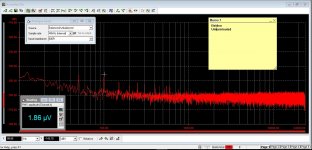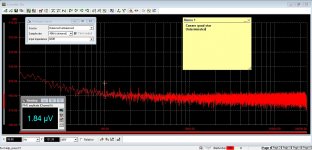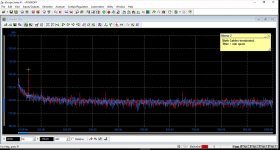Yes, I took the triangle only as an example for an easy to correct
waveform, it would be braindead as the starting point for a low
harmonics source.
I'm more into ATE than audio ;-) , say V93000 and now
precise time / frequency / phase noise stuff.
waveform, it would be braindead as the starting point for a low
harmonics source.
I'm more into ATE than audio ;-) , say V93000 and now
precise time / frequency / phase noise stuff.
And removing harmonics with notch filters is easy.
The notch filter would be only active on harmonics that are already -100 dB
down. No need for extra large inductors then.
regards, Gerhard
How can you sync a 2X or 3X variable freq notch filter to the gen source freq?
THx-Richard M.
How can you sync a 2X or 3X variable freq notch filter to the gen source freq?
THx-Richard M.
Why variable? you need just 2 or 3 frequencies for the measurements.
Anything that tunes a LC circuit makes it worse every respect.
BTW I have bought some of these devices:
< http://www.mouser.com/ds/2/389/stptic-27l2-956732.pdf >
I have no idea how they work & why they have a lower frequency.
They don't seem to be varicaps.
Have not yet tested them, way to much in the pipeline in front of them.
Gerhard
You could always tune it for minimum output on a DDS-generated harmonic.
That could be same DDS that provides the main output during measurement.
That could be same DDS that provides the main output during measurement.
...one could use a dual-matched JFET... some cancellation of JFET distortion in the balanced condition...
I still want to try this idea.
I think the 2N4091 was chosen based mainly on the pinch-off, up to 10V.
What's the maximum pinch-off anyone knows for a dual FET?
I wonder how potentially better matched but lower pinch-off dual FET compares with hand matched 2N4091.
Unless anyone has a better FET?
David
I still want to try this idea.
I think the 2N4091 was chosen based mainly on the pinch-off, up to 10V.
What's the maximum pinch-off anyone knows for a dual FET?
I wonder how potentially better matched but lower pinch-off dual FET compares with hand matched 2N4091.
Unless anyone has a better FET?
David
Dave you might want to look at the JFET's intended as VCR's, I think Linear Systems is making a few of the discontinued ones.
EDIT - VCR11N dual 8-12V Vp, email Paul Norton at Linear Systems and tell him it's for DIYaudio mention me if need be and he should send a few samples.
Last edited:
EDIT - VCR11N dual 8-12V Vp
Thanks Scott, that looks perfect - dual matched and optimized as a VCR with consequent elevated pinch-off.
Even a TO-71, I still feel a sentimental attachment to the old style transistors that I associate with early university days.
Best wishes
David
do you guys who do very low thd measurements use star quad cables for balanced measurements ? Any experience ? I saw a video on benchmarks website which showed fairly significant improvement in interference rejection. Belden also has some info on its site saying that its better than even perfectly implemented stainless steel conduit for rejecting LF interference... How Starquad Works
do you guys who do very low thd measurements use star quad cables for balanced measurements ? Any experience ? I saw a video on benchmarks website which showed fairly significant improvement in interference rejection. Belden also has some info on its site saying that its better than even perfectly implemented stainless steel conduit for rejecting LF interference... How Starquad Works
What makes you thing stainless steel conduit is good for rejecting LF magnetic interference?
No particular reason - just parroting their spiel.
I think what they said sounds good, but yes, it appears to be intended to impress.
Regarding what cables people here use for measurements, I get the impression it varies. Some people apparently have very low interference environments. In other situations, with stray noise pickup the solution often has to be tailored to the problem, more so with noisier environments and more sensitive measurements. Sometimes just moving things around can make a big difference.
Many stainless alloys are non-magnetic. Some galvanized pipe would provide better shielding at low frequencies for magnetic fields. Electrostatic fields just need a conductive shield connected to the right place. I get a sense for marketing pitch here. Not typical for Benchmark on this stuff. However a "Star Quad" (which I think is Mogami's trademark) should have better cancellation for magnetic fields.
Measuring really low HD requires lots of care. Most sources are single ended so balanced connection just add circuitry, which in turn degrades the distortion.
Measuring really low HD requires lots of care. Most sources are single ended so balanced connection just add circuitry, which in turn degrades the distortion.
Thanks. I use pretty much all balanced setups. I just popped into the local and got some of the Canare L46ES.
The mains interference in my measurements is driving me nuts! So I guess I'll just try it vs twin shielded ( not the GI or SS conduit!) and report back.
I though that the vid on benchmarks website was pretty convincing but then again my wife says I'm a sucker for pseudo scientific marketing !
The mains interference in my measurements is driving me nuts! So I guess I'll just try it vs twin shielded ( not the GI or SS conduit!) and report back.
I though that the vid on benchmarks website was pretty convincing but then again my wife says I'm a sucker for pseudo scientific marketing !
Last edited:
... its better than even perfectly implemented stainless steel conduit...
Many stainless alloys...
This struck me as odd too so I read the Belden link, it says "solid steel" not stainless.
I think perhaps Kasey simply misread it?
But I have had Star Quad in mind for a while, nice to see others with a similar idea.
Best wishes
David
Last edited:
yes sorry i misspoke - the blurb said steel and not stainless steel. That I was out shopping for some construction fixtures yesterday is the only excuse I can offer.
quote:
"....There is no shield of any kind that we can apply to a cable that has any effect on that low frequency. Even a solid steel conduit, perfectly installed, is only around 30 dB of noise rejection at 60 Hz. But starquad cable is up to 50 dB noise rejection at 60 Hz."
quote:
"....There is no shield of any kind that we can apply to a cable that has any effect on that low frequency. Even a solid steel conduit, perfectly installed, is only around 30 dB of noise rejection at 60 Hz. But starquad cable is up to 50 dB noise rejection at 60 Hz."
yes sorry i misspoke...
No problem.
As I said I am interested in this too, seems like it should be better.
I may need this if my low distortion oscillator works as well as theory says.😉
If you try it then I would be curious to learn your results.
Best wishes
David
Star quad vs STP is more of a question in the system it was developed for, mic level signals. The increased capacitance line to line of star quad can have an affect on passive microphones tonal quality, active mics with their lower output impedance exhibit less interaction.
All of which depends on length as well. Star quad arrangement does work in the real world. And of course it also depends on the balance of the following differential input. Transformers still being the most reliable configuration.
from the trenches
Cheers
Alan
All of which depends on length as well. Star quad arrangement does work in the real world. And of course it also depends on the balance of the following differential input. Transformers still being the most reliable configuration.
from the trenches
Cheers
Alan
Star Quad Simple Test
I started to do the test only to notice that the usually ubiquitous mains EMI pollution shrouding my test bench had fallen away quite a bit!
Still, in this environment i found a small (but worthwhile to me) improvement.
You can take a look and decide whether its worth your time and the $2/M for the cable.
I started to do the test only to notice that the usually ubiquitous mains EMI pollution shrouding my test bench had fallen away quite a bit!

Still, in this environment i found a small (but worthwhile to me) improvement.
You can take a look and decide whether its worth your time and the $2/M for the cable.
Attachments
I don't have ground or power problems.
1. I float all equipment from ground... use 3-2 ac adapters.
2. Run ac line thru ac line filters.
3. Isolate the test equipment via isolation transformers.
For RFI/EMI, a shielded aluminum box for the DUT/CUT does the job.
Most of the measurements are single ended. Regular coax.
-RNMarsh
1. I float all equipment from ground... use 3-2 ac adapters.
2. Run ac line thru ac line filters.
3. Isolate the test equipment via isolation transformers.
For RFI/EMI, a shielded aluminum box for the DUT/CUT does the job.
Most of the measurements are single ended. Regular coax.
-RNMarsh
Richard thanks. It was due to your suggestions some years ago that i converted my test setup to using isolated and filtered AC - i found this to be essential.
The cables are I guess more a case of guilding the lilly. 😛
Yesterday I redid the tests with the unused ends terminated with 100r termination. I found that the starquads made a very worthwhile difference (look at the 50hz component which is down 17db or so) and so I will be converting all my test cables to the as I go along. Of course ymmv 😀
The cables are I guess more a case of guilding the lilly. 😛
Yesterday I redid the tests with the unused ends terminated with 100r termination. I found that the starquads made a very worthwhile difference (look at the 50hz component which is down 17db or so) and so I will be converting all my test cables to the as I go along. Of course ymmv 😀
Attachments
- Home
- Design & Build
- Equipment & Tools
- Low-distortion Audio-range Oscillator


